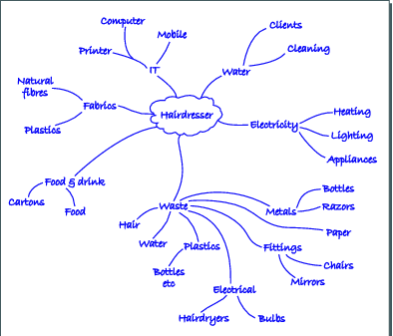2 Connecting organisations and environment
Although you have already begun to explore some ways in which organisations might be connected to the environment in previous activities, it is possible that some organisations will argue that they have no particular connection to the environment. Examples might be a medical charity set up to help patients access care services on leaving hospital, a local legal firm or a pizza takeaway. In this sense the organisations might identify themselves as being completely separate from environmental concerns. Is this sense of separation valid?
Activity 18 Connecting organisations and environment
Select a (non-environmental) organisation that you have some familiarity with (remember you don’t need to be an employee or similar). Identify any possible connections to the natural environment using a spray diagram.
(Note: guidance on drawing spray diagrams is available in the Guide to diagrams [Tip: hold Ctrl and click a link to open it in a new tab. (Hide tip)] .)
Discussion
My spray diagram is of my hairdressers (or perhaps more precisely, barbers). Water is used for cleaning the shop and for clients; electricity is used for several purposes, including lighting and powering various appliances. Waste is generated in many forms and types, suggesting this could be a significant way in which the hairdressers is connected to the environment. Other connections include food and drink provision for clients and staff, and, of course, ICT equipment including computer and telephones.
Far from being unconnected, the spray diagram shows that this organisation has a wide range of environmental connections.
Your spray diagram should indicate some connection to the environment. It is almost inevitable that all organisations will have connections, however limited in scope and extent, to the natural environment. This is not entirely surprising if you remember that an organisation is a group of people organised for a purpose. As a result, even the least environmentally ‘connected’ organisation is still likely to be ‘connected’ in the form of energy, water, land and materials used, and wastes and emissions generated by the members of the organisation as they go about their activities within the organisation. Whether the organisation recognises these connections is a different question. Nonetheless, it is quite a challenge to conceive of an organisation that does not have some kind of connection to the natural environment – you are welcome to try!
In this course, we will accept that, for all practical purposes, all organisations are connected to the natural environment in some fashion. It follows that some exploration of those connections is possible and important for understanding and managing human–environment relations, and the extent to which (and how) they are changed through innovation.
To start with, let’s consider the two simplest ways organisations might be connected to their environment: the involvement of an organisation in creating or contributing to the environmental issue of concern; and the effect of environmental issues on an organisation. We explore both dimensions briefly.

